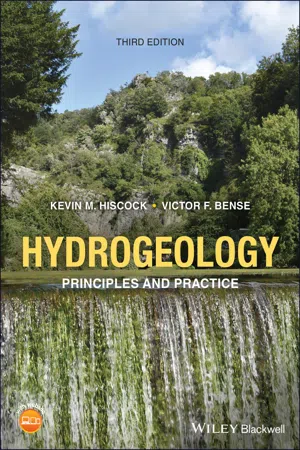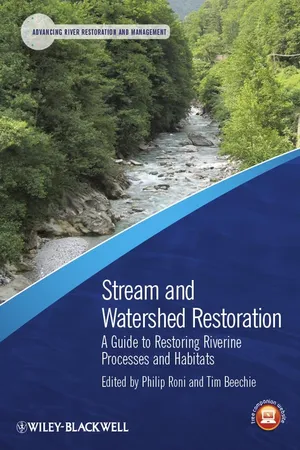Hydrological Processes
Hydrological processes refer to the movement, distribution, and quality of water on Earth. These processes include precipitation, evaporation, transpiration, infiltration, runoff, and groundwater flow. They play a crucial role in shaping landscapes, influencing ecosystems, and impacting human activities such as agriculture, industry, and urban development. Understanding hydrological processes is essential for managing water resources and addressing environmental challenges.
3 Key excerpts on "Hydrological Processes"
- Amithirigala Widhanelage Jayawardena(Author)
- 2021(Publication Date)
- CRC Press(Publisher)
...Chapter 25 Hydrological cycle and its principal processes 25.1 Introduction Hydrology can be defined as the science that treats the waters of the earth, their occurrence, circulation and distribution, their physical and chemical properties and their reaction with the environment, including their relation to living things. This is the definition adopted by the US Council for Science and Technology. Hydrology is a multi-disciplinary subject and its development and applications have come from Civil Engineering, Soil Physics, Agriculture, Forestry, Geomorphology, Geography, etc. That part of Hydrology relevant to the Civil Engineer is called Applied Hydrology or Engineering Hydrology, whereas Scientific Hydrology refers to the study of the fundamental physical, chemical and biological processes of the Hydrological cycle. In engineering hydrology, there are three basic problems: Measurement, recording and publication of basic data Analysis of these data to develop and expand fundamental theories Application of these theories and data to practical problems. In scientific hydrology, it is studied under the following areas: Hydrometeorology : study of problems intermediate between the fields of hydrology and meteorology, e.g., precipitation, evaporation, etc. Limnology : study of lakes Cryology : study of snow and ice Potamology : study of surface water Geo-hydrology (groundwater hydrology) : study of groundwater Oceanology : study of the oceans. Three main international organizations that have contributed to and promoted the understanding and development of hydrology are: International Association of Hydrological Sciences (IAHS) (since 1922), International Hydrological Decade (IHD) (1965–1974), and, International Hydrological Programme (IHP) (1975 onwards). 25.2 Hydrological cycle Earth’s water resources are in a state of continuous circulation linking the atmosphere, land and the oceans...
- eBook - ePub
Hydrogeology
Principles and Practice
- Kevin M. Hiscock, Victor F. Bense(Authors)
- 2021(Publication Date)
- Wiley-Blackwell(Publisher)
...3 Groundwater and geological processes 3.1 Introduction This chapter discusses the response of groundwater systems to geological processes such as plate tectonics, glaciation and sea‐level fluctuations. Although topography‐driven groundwater flow, as introduced in Chapter 2, is in many areas of the world the dominant mode of groundwater circulation, consideration of the additional impact of geological processes on groundwater flow is often important to fully appreciate the dynamics of groundwater systems on relatively long timescales (millennia). For example, only by considering the hydrogeological impacts of glaciation and associated sea‐level low stand, can the occurrence of fresh water underneath the sea‐floor along much of the continental shelf be understood. In the description of regional groundwater flow systems, which typically reach circulation depths of several kilometres, flow driven by the variable density of groundwater and flow induced by stresses imposed on pore fluids play an important role and often form the sole driver of fluid flow in the absence of topographically driven flow. The variable density of groundwater and anomalous pore pressures can be caused by a suite of geological processes. Thus, to understand fluid flow patterns in relatively deep hydrogeological systems requires an understanding of how the relevant geological processes cause fluid flow. It is the task of the hydrogeologist to evaluate, for a given geological setting, which processes can be expected to be dominant in driving fluid flow in the subsurface. The way groundwater and other geofluids, such as hydrocarbons, respond to geological forcing often has a direct feedback on how geological processes proceed. This feedback mechanism is, for example, important when the influence of fluids on seismicity should be considered...
- eBook - ePub
Stream and Watershed Restoration
A Guide to Restoring Riverine Processes and Habitats
- Philip Roni, Tim Beechie, Philip Roni, Tim Beechie(Authors)
- 2012(Publication Date)
- Wiley-Blackwell(Publisher)
...2 Watershed Processes, Human Impacts, and Process-based Restoration Tim Beechie 1, John S. Richardson 2, Angela M. Gurnell 3 & Junjiro Negishi 4 1 Northwest Fisheries Science Center, National Oceanic and Atmospheric Administration, USA 2 University of British Columbia, Canada 3 Queen Mary, University of London, UK 4 Hokkaido University, Japan 2.1 Introduction Effective planning, design, and implementation of river restoration efforts each require an understanding of how watershed processes drive the structure and functions of riverine ecosystems, as well as how those processes support a wide variety of ecosystem services. In this book, the term ‘watershed process’ generally refers to movements of landscape or ecosystem components into and through river systems, which are typically measured as rates (Beechie & Bolton 1999). For example, erosion is a process that moves sediment from hillslopes to river channels, while sediment transport processes move sediment through stream and river channels to deltas and estuaries. Erosion is measured in units of mass/area/time, whereas sediment transport is commonly measured in units of mass/time. We do not restrict the term ‘processes’ to geomorphological or Hydrological Processes, but instead refer to a wide range of processes including erosion and sediment transport, storage and routing of water, plant growth and successional processes, delivery of nutrients and organic matter, inputs of thermal energy, trophic interactions, species interactions, and population dynamics. Understanding these processes and relationships between them is critical to the success of river restoration programs. These driving processes influence states and dynamics of biological communities through a sequence of cause–effect linkages that connect watershed processes to habitat conditions, and habitat conditions to biota (Figure 2.1)...


